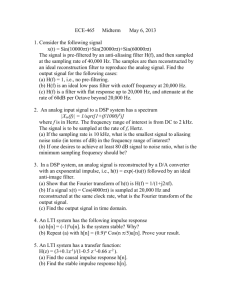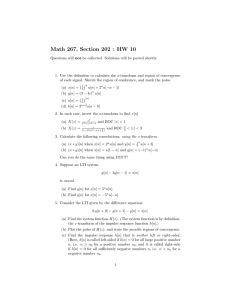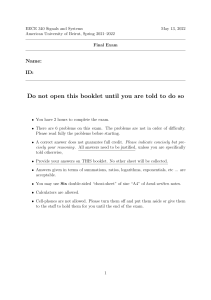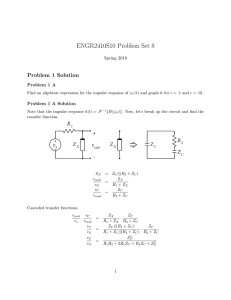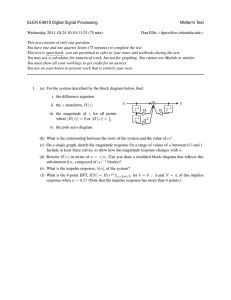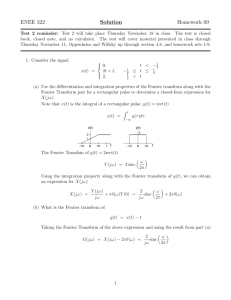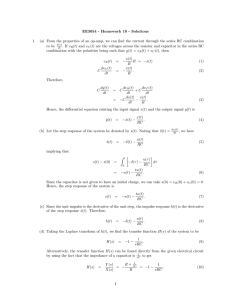Digital Signal Processing: Time Delays & Group Delay
advertisement
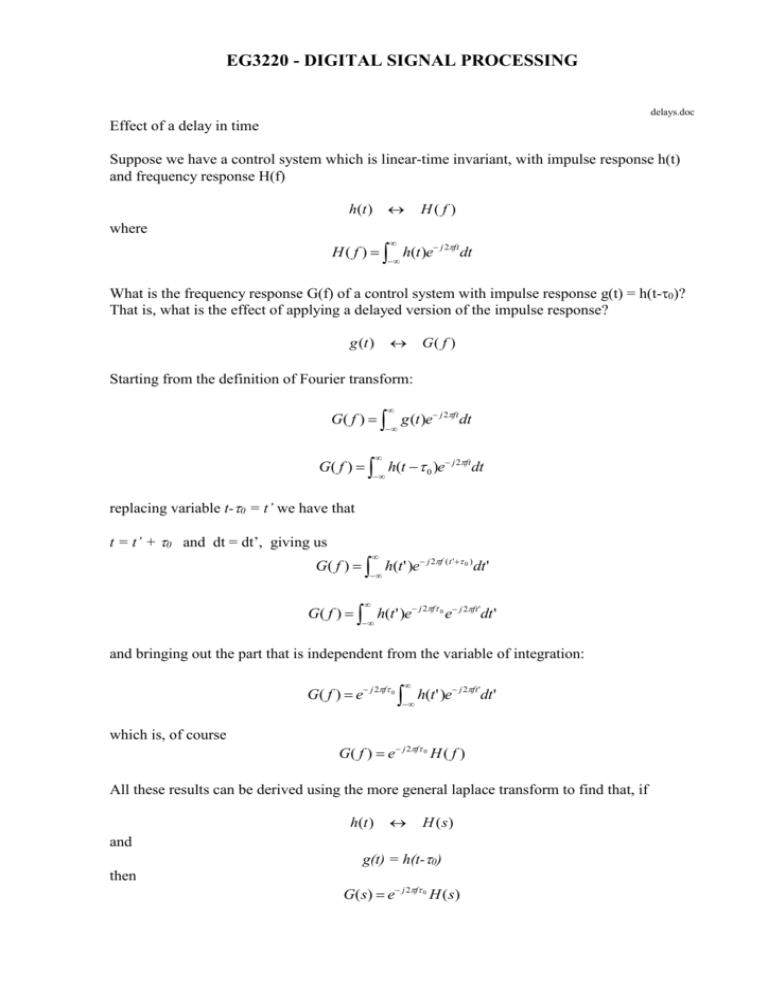
EG3220 - DIGITAL SIGNAL PROCESSING delays.doc Effect of a delay in time Suppose we have a control system which is linear-time invariant, with impulse response h(t) and frequency response H(f) h(t ) H( f ) where H ( f ) h(t )e j 2ft dt What is the frequency response G(f) of a control system with impulse response g(t) = h(t-0)? That is, what is the effect of applying a delayed version of the impulse response? g (t ) G( f ) Starting from the definition of Fourier transform: G( f ) g (t )e j 2ft dt G( f ) h(t 0 )e j 2ft dt replacing variable t-0 = t’ we have that t = t’ + 0 and dt = dt’, giving us G( f ) h(t ' )e j 2f (t ' 0 ) dt ' G( f ) h(t ' )e j 2f 0 e j 2ft 'dt ' and bringing out the part that is independent from the variable of integration: G( f ) e j 2f 0 h(t ' )e j 2ft 'dt ' which is, of course G( f ) e j 2f 0 H ( f ) All these results can be derived using the more general laplace transform to find that, if h(t ) and H ( s) g(t) = h(t-0) then G( s) e j 2f 0 H ( s) What does that mean (for a digital controller?). It means that the control action will be taken later ( 0 samples later). This might be a problem. Group delay The group delay of a system is a measure of the average delay of the system as a function of frequency. It is defined as the negative first derivative of the system’s phase response. If the complex frequency response of a system is H(ej), then the group delay is G ( ) d ( ) d where = 2f is the angular frequency and (w) is the phase angle of H(ej), that is, d arg H (e j ) d G ( ) Linear phase corresponds to constant delay: G ( ) d ( ) d or group delay ( f ) ( phase) (f) This means that if a system’s transfer function has linear phase in the pass band then all harmonics corresponding to the pass band will be submitted to the same time delay and they add up maintaining the same phase relation as in the non-filtered original signal, that is, there is no “phase distortion”. This is what makes “linear phase” an interesting characteristic for a transfer function of a control system. Frequency response of a discrete LTI system and delays Example: Moving Average Digital Filter Difference equation: y ( n) 1 L x(n i ) L 1 i 0 Frequency response: The frequency response of a discrete-time LTI system is the Fourier transform of the impulse response h(n) (or the z-transform calculated on the unit circle, that is, for z = ejT ) : H z z e jT h(nT )z n and, using simplified notation, this is written n z e jT H e j h(n)e jn n 1 L +1 h( n) = The impulse response is for 0 n L for n < 0 or n > L h(n) = 0 this gives 1 L j n e L 1n 0 H e j remembering that N2 k n N1 N1 N 2 1 1 we can write H e j 1 L jn 1 e0 e j ( L 1) e L 1 n 0 L 1 1 e j multiplying and dividing by the same amounts H e j j ( L 1) 1 1 e L 1 1 e j e e j ( L 1) 2 j ( L 1) 2 we have H e j 1 e L 1 j ( L 1) 2 e j 2 e e j ( L 1) 2 j 2 e j ( L 1) 2 j e2 1 L 1 e e j 2 j 2 sin L 1 jL 2 e 2 sin 2 that is 1 H ( e j ) L 1 sin ( L 1) jL 2 2 e sin 2 and the group delay is given by G ( ) d arg H (e j ) d L d 2 L G ( ) . d 2 For instance the group delay of y (n) 1 4 x(n) x(n 1) x(n 2) x(n 3) x(n 4) x(n i ) 5 i 0 5 is 2 samples. © F.S. Schlindwein

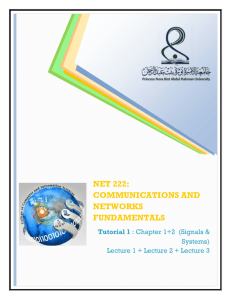
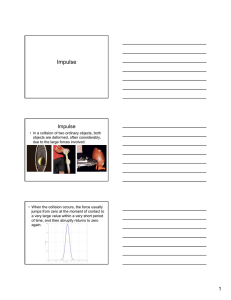
![2E2 Tutorial sheet 7 Solution [Wednesday December 6th, 2000] 1. Find the](http://s2.studylib.net/store/data/010571898_1-99507f56677e58ec88d5d0d1cbccccbc-300x300.png)
